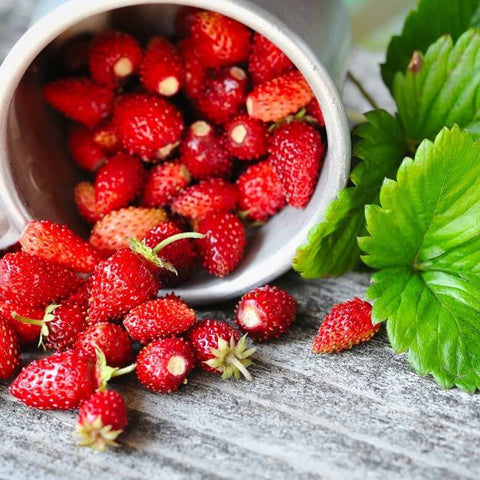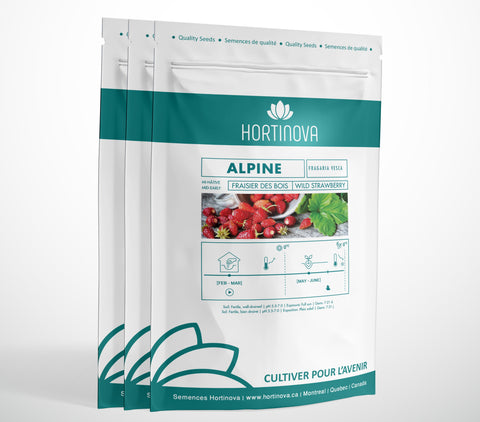

Hortinova
ALPINE - Open Pollinated Strawberry Seeds
Fragaria vesca
- Early and high-yielding European heirloom variety.
- Remontant strawberry variety that does not produce runners.
- Compact plant with spherical bush habit that can reach 18 cm in height.
- Produces clusters of large white flowers followed by intensely delicious red berries, naturally everbearing from June to late fall.
- Unpretentious, productive plant, and surprisingly decorative. Can be grown on the balcony.
- Can be grown in the open field with the use of temporary low tunnels if necessary.
- Strong tolerance to frequent changes in weather.
Start the seeds indoors 10 to 12 weeks before your average last frost date. This gives the plants time to grow strong indoors and extends each plant’s growing season. Fill seed trays or small pots with a well-draining seed-starting mix. Moisten the soil, then sow the seeds on the surface and gently press them into the soil. Strawberry seeds require light to for the best germination results so do not bury the seeds with soil. Gently spray the soil with water and be careful not to dislodge the seeds from the soil.
Cover the tray with a clear plastic lid or plastic wrap to create a mini-greenhouse effect. Place the seed tray in a warm location with indirect sunlight, such as a windowsill or under a grow light. The ideal germination temperature is around 65-75°F (18-24°C). Keep the soil consistently moist but not waterlogged. Seeds require consistent moisture to germinate. Strawberry seeds typically take between 1-2 weeks to sprout.
TRANSPLANT: Once the seedlings have developed their first true leaves (usually after 4-6 weeks), they are ready for transplanting however only transplant outdoors after the last frost date in your area. Gradually accustom plants to outside conditions (avoid frosts), before planting out in May-June. Choose a location in your garden with fertile well-draining soil, full sun with partial shade. Raised beds are a particularly good option for strawberry plants. Soil pH should be slightly acidic between 5.5 and 7.0. Take care not to damage the roots while removing the seedlings from the see tray. Dig holes in the prepared garden bed, spaced about 12-18 inches apart. Plant the seedlings at the same depth they were in the seed tray and water them gently after transplanting.
WATER: Moisture is incredibly important to strawberries due to their shallow roots. Water your strawberry plants at the base, avoiding wetting the foliage. Keep the soil consistently moist but not waterlogged throughout the growing season. Consider using a drip irrigation system to provide consistent moisture without wetting the leaves, which can lead to disease. Water adequately, about one inch per square foot per week. Strawberry plants need a lot of water when the flowers are developing and again in the late summer, when the plants are fully mature and gearing up for winter dormancy.
PROTECT: Mulch around the base of the plants with straw or wood chips to retain soil moisture and suppress weed growth. Regularly inspect your plants for signs of pests such as aphids, slugs, and snails. If you notice any infestations, take appropriate measures to control them. This could include using organic insecticides such as neem seed oil, introducing beneficial insects, or physically removing the pests. Maintain good air circulation by spacing plants properly and removing any dead or diseased leaves.
FEED: Use a balanced, granular slow-release fertilizer at the beginning of the season, or a liquid option as much as once a week.
PRUNE: Regularly remove any dead or yellowing leaves to promote better airflow and reduce the risk of disease. For the first year of your strawberry plants’ life, they need to focus energy on establishing good roots. The rule of thumb is to clip off the first round of blossoms in June. This should result in a stronger plant and plumper strawberries in the next crop. Alpine strawberries are perennial plants, so they will continue to produce fruit for multiple years if well-maintained.
The alpine strawberries will start producing fruits in early summer, and the harvest season can last until late fall. The fruits will be about the size of a fingernail. Harvest the ripe berries when they are fully red and have a sweet aroma. Gently pick the strawberries to avoid bruising. Decaying fruits may invite pests and disease, so try to stay on top of harvesting them.
Let customers speak for us
from 2 reviewsTRISTAN F1 - Hybrid Summer Squash Seeds

KOSAK - Open Pollinated Red Beet Seeds












